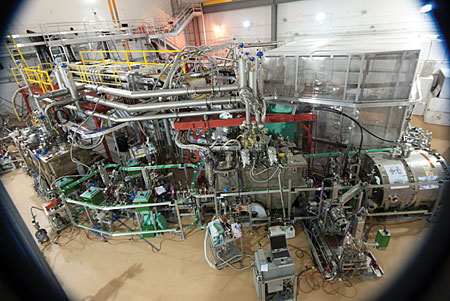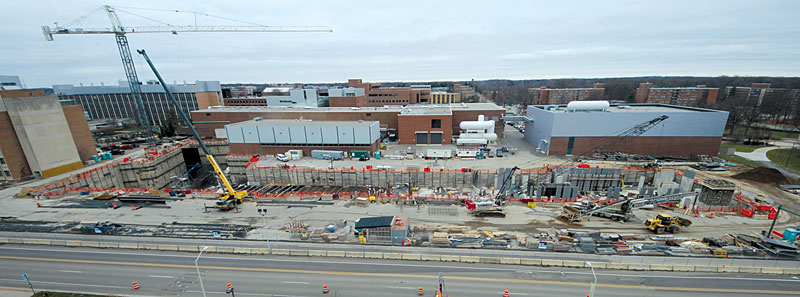Rare isotopes will be used to probe mysteries, yield applications
DOI: 10.1063/PT.3.2682
Exotic isotopes will soon become less exotic, thanks to two new North American facilities in the works. The Advanced Rare Isotope Laboratory (ARIEL) at TRIUMF, Canada’s particle and nuclear physics lab in Vancouver, British Columbia, is on target to start experiments in 2017 and build up in phases through 2021. And the Facility for Rare Isotope Beams (FRIB) at Michigan State University (MSU) is set to start up by 2022.
Rare isotopes may help decode how heavy elements form and what lies beyond the standard model. In addition, the new facilities will produce isotopes for materials, environmental, and medical research and applications. Alpha-emitting isotopes such as actinium-225, for example, “hold promise for treating late-stage and difficult-to-locate cancers,” says ARIEL project leader Lia Merminga.
At ARIEL, a proton or electron beam hits a target. Isotopes resulting from interactions diffuse to the target surface and form an ion beam that is separated by mass and transported to experiments. Known as isotope separation on line (ISOL), the method creates high-intensity beams of uniform, controlled energy. Isotopes that decay too quickly do not make it to the surface, so ISOL is best for producing longer-lived species (half-life greater than about 5 ms). ARIEL clocks in at Can$100 million ($83 million).
Once ARIEL is completed, TRIUMF will have three high-power driver beams: Two 500-MeV proton beams—a new one and the one at the existing Isotope Separator and Accelerator (ISAC) facility—and a 50-MeV superconducting electron linear accelerator. The first phase of the electron linac came on line last September (see upper photo). Electrons create neutron-rich species through photofission, while proton collisions produce mostly neutron-deficient species via spallation.

KYLA SHAUER/TRIUMF

Having multiple beamlines provides flexibility, Merminga says, “so we can quickly react. We can go after interesting science when it’s hot.” It also makes long-running experiments possible, she notes. “We will be able to look for very small effects that require lots of data—fundamental symmetries, new forces.”
One of the first directions planned for ARIEL is to make polarized lithium-8 by bombarding a beryllium target with electrons. Researchers will measure magnetic properties of thin films and layered materials.
At FRIB (lower photo), isotopes will be produced through in-flight collisions. Heavy ions will be accelerated to 200 MeV per nucleon—48 GeV for uranium-238, for example—and shot at a foil or solid target. The resulting fragments will then be collected and sorted for study. The in-flight approach produces more types and shorter-lived isotopes than ISOL. “FRIB will produce more than 1000 new isotopes at useful rates,” says associate laboratory director Brad Sherrill.

ALEX PARSONS, MICHIGAN STATE UNIVERSITY

“In-flight fragmentation works well at high energies,” says MSU’s Hendrik Schatz. “But what comes out is rare isotopes at very high energies. So we have rare isotopes at the wrong energies for astrophysical studies.” Schatz is working on an instrument to “stop the isotopes in a gas cell. We cool them to get rid of the spreads [in energy and momentum], then we extract isotopes in an orderly manner.” The plan is to pair the gas cell and reacceleration with a magnetic mass separator for astrophysical capture reactions, known as SECAR. If SECAR is successful, ISOL facilities will lose some of their advantage in creating low-energy beams.
The estimated price tag for FRIB is $730 million, with the state of Michigan putting in $94.5 million and the US Department of Energy covering the rest. That does not include SECAR, which is expected to cost about $13 million, or other instruments needed to best exploit FRIB.
The current premier in-flight facility for exotic isotopes is the Radioactive Isotope Beam Factory in Japan, and the leading ISOL facilities are ISAC and CERN’s ISOLDE. A handful of rare-isotope facilities are in various stages of planning and use in China, France, India, and South Korea. The Facility for Antiproton and Ion Research in Darmstadt, Germany, is ambitious but over budget and behind schedule.
The burgeoning of rare-isotope facilities is endorsed by the Organisation for Economic Co-operation and Development. In 1999, for example, the OECD Working Group on Nuclear Physics said that “pursuing the complex set of scientific goals … requires a wide variety of beam species over a broad range of beam energies… . It is thus essential that several complementary high-intensity, next-generation RNB [radioactive nuclear-beam] facilities be built world-wide.” The OECD study group also acknowledged “a strong need for more than one major facility of each of the two basic types, ISOL and In-Flight.”
More about the Authors
Toni Feder. tfeder@aip.org
